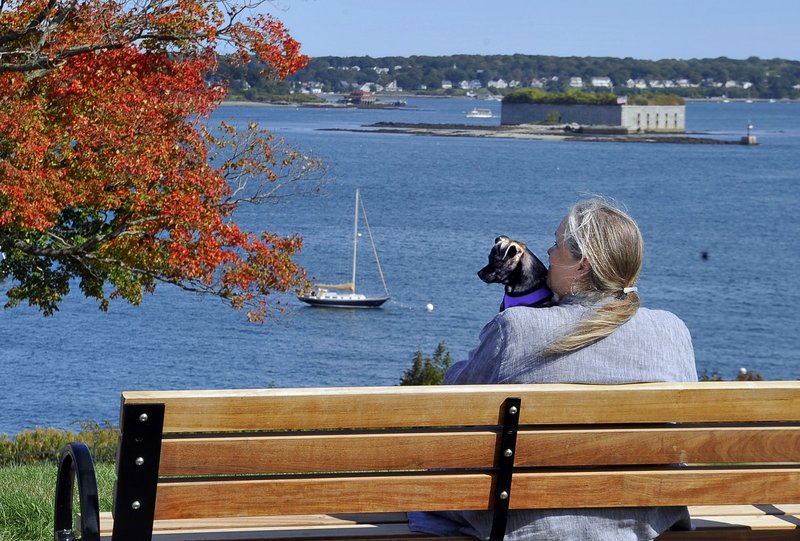PORTLAND – In 1828, Portland acquired land on the east end of the peninsula with an eye toward public use. Nine years later, the city built a roadway along the Eastern Promenade from Fore Street to Washington Avenue, while at the same time constructing a similar street on the Western Promenade.
However, the city did not own the land on the ocean side of the Eastern Promenade, and in the decades that followed, various development proposals threatened this prime open space with its unrestricted view of Portland Harbor and Casco Bay.
By the early 1880s, the site known as Fort Allen, which had served as an artillery battery in both the American Revolution and the War of 1812, was being considered for a hotel.
Local historian William Goold rose to its defense in 1883 by writing a newspaper article titled “An Historic Lot,” in which he reminded his fellow citizens:
“The lot named has a more beautiful outlook than any other vacant space in the city and should be preserved as an open space. Whatever occupies this ancient site, it should not be a hotel, to shut out all that is beautiful of the landscape.”
Goold went on to describe how the view from Fort Allen appeared in 1883:
“The varied landscape is now the chief attraction of the spot. Southeast is Fort Gorges with its numerous battlements, and further on is Fort Preble, the headquarters of the military defenders of the city, with its starry flag, which is saluted by the morning and evening gun. In full view of the site of the old fort, and in a nearly straight line six or seven miles long are the white towers of four lighthouses — pillars of cloud by day, and pillars of fire by night, to guide the mariner to our port. Beneath the bluff, almost hourly, come the thundering Grand Trunk trains laden with the products of the far West, to be dumped into the hungry holds of the immense steamships, which noiselessly glide away to feed the people of Europe.”
Goold’s plea was eventually heard, and by April 1890, the city had negotiated to buy the 2.5-acre Old Fort lot, as it was called, for a park at a cost of $15,000.
When the purchase from the Deering heirs was completed that spring, the land was placed under the care of the Parks Commission and Portland’s talented city engineer, William A. Goodwin.
The planner of many civic improvements in late 19th-century Portland, Goodwin immediately set to work developing the grounds with an access road, lawns and a bandstand designed by architects John Calvin Stevens and Albert Winslow Cobb — the very bandstand still there today.
Goodwin planted low-growing shrubbery but was careful not to locate trees where they would obstruct the views.
That summer, the Portland Street Railroad extended its horse car tracks along the southern section of the Eastern Promenade as far as the new park, thereby, in Goodwin’s words, “opening this superb view to thousands who would not otherwise have seen it.”
Portland’s commitment to an Eastern Promenade roadway in 1837 and the creation of Fort Allen Park in 1890 led to the efforts of six-term Mayor James P. Baxter in 1905 to have the city acquire 21 acres of open space on the ocean side of the promenade, thus ensuring permanent public access to the views of the harbor and the bay. As Baxter wrote that year in his report “The Park System of Portland”:
“Nearly the entire territory was private property, though but a few of our citizens seemed to realize this, for, when it was alluded to the common remark was, ‘I always supposed the Eastern Promenade belonged to the city.'”
Thanks to the vision of two historians, William Goold and James P. Baxter, with the support of other interested citizens of their time, Fort Allen Park and the Eastern Promenade have been among Portland’s most appreciated public spaces for more than a century.
Earle G. Shettleworth Jr. of Portland is Maine state historian.
Send questions/comments to the editors.



Success. Please wait for the page to reload. If the page does not reload within 5 seconds, please refresh the page.
Enter your email and password to access comments.
Hi, to comment on stories you must . This profile is in addition to your subscription and website login.
Already have a commenting profile? .
Invalid username/password.
Please check your email to confirm and complete your registration.
Only subscribers are eligible to post comments. Please subscribe or login first for digital access. Here’s why.
Use the form below to reset your password. When you've submitted your account email, we will send an email with a reset code.